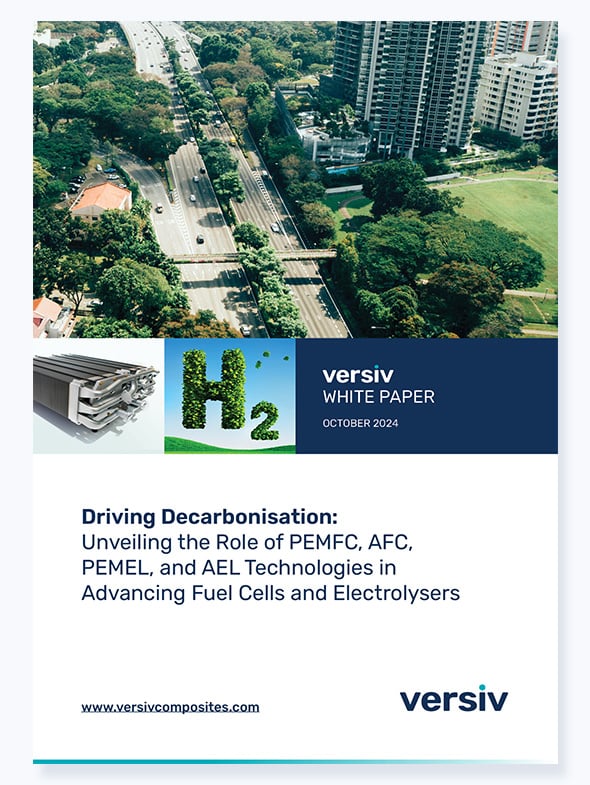

Hydrogen technologies are the cornerstone of global decarbonisation strategies, particularly in hard-to-abate sectors like heavy transport and industrial manufacturing. Among these solutions, Proton Exchange Membrane fuel cells and electrolysers (PEMFC / PEMEL) and Alkaline-based electrolysers (AEL) — are critical for enabling green hydrogen production and utilisation. Versiv Composites participates in this transition, delivering specialised hydrogen sealing solutions that address the unique demands of these technologies.
The Role of PEMFC and Alkaline Systems in Decarbonization
PEMFCs dominate the mobility sector due to their dynamic operation (50–150 kW stacks) and compatibility with fluctuating power inputs, making them ideal for trucks and passenger vehicles. Their ability to operate at moderate pressures (1–3 bar) and temperatures (60–175°C) ensures efficiency without requiring complex thermal management.
On the hydrogen production side, PEMELs excel in decentralised, intermittent hydrogen generation, pairing seamlessly with renewables to achieve gas purity levels >99.97%. Meanwhile, AELs remain the workhorse for large-scale, continuous hydrogen output, with single stacks reaching 10 MW+ and lifespans exceeding 90,000 hours. Their superiority in static, high-efficiency (70%) environments make them indispensable for industrial ammonia and steel production.
Sealing Challenges and Versiv Innovations
The operational success of these systems hinges on robust sealing. PEMFCs demand gaskets resistant to hydrogen embrittlement and thermal cycling, while PEMELs require materials that withstand high-pressure differentials (≤0.3 bar) and acidic conditions. Alkaline systems (AEL) present additional hurdles, as their liquid electrolytes necessitate corrosion-resistant seals capable of enduring potassium hydroxide exposure.
Versiv Composites addresses these hydrogen sector challenges through:
- Customised materials: Engineered for chemical stability in both acidic (PEM) and alkaline environments, reducing downtime and maintenance costs.
- Precision Compression Control: Ensuring leak-free operation across pressure variances, critical not only for PEMELs in renewable energy buffering.
- Durability Enhancements: Extending PEMFC gasket lifespans beyond 30,000 hours—a 20% improvement over industry standards.
Market Outlook and Strategic Opportunities
The PEM sector is projected to grow at a 14% CAGR through 2030, driven by demand for fuel cell trucks and green hydrogen infrastructure. However, AELs will retain dominance in bulk hydrogen production, accounting for 65% of electrolyser installations by 2030. Versiv Composites ability to serve both markets positions it well in scaling hydrogen ecosystems.
Future Directions: Materials Science as a Decarbonization Accelerator
Emerging innovations, such as anion-exchange membranes (AEMs), promise to merge PEM dynamics with alkaline cost benefits. Versiv R&D in hybrid sealing solutions aligns with this trend, ensuring compatibility with next-generation fuel cell stacking while reducing platinum dependency by up to 40%.
By bridging material science with hydrogen engineering, Versiv Composites is supporting and actively aiming to accelerate the transition to net-zero industries—one seal at a time.





